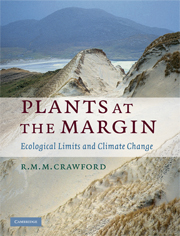Book contents
- Frontmatter
- Contents
- Preface
- Acknowledgements
- PART I THE NATURE OF MARGINAL AREAS
- PART II PLANT FUNCTION IN MARGINAL AREAS
- PART III MARGINAL HABITATS – SELECTED CASE HISTORIES
- 5 Arctic and subarctic treelines and the tundra–taiga interface
- 6 Plant survival in a warmer Arctic
- 7 Land plants at coastal margins
- 8 Survival at the water's edge
- 9 Woody plants at the margin
- 10 Plants at high altitudes
- 11 Man at the margins
- 12 Summary and conclusions
- References
- Author index
- Species index
- Subject index
11 - Man at the margins
Published online by Cambridge University Press: 06 July 2010
- Frontmatter
- Contents
- Preface
- Acknowledgements
- PART I THE NATURE OF MARGINAL AREAS
- PART II PLANT FUNCTION IN MARGINAL AREAS
- PART III MARGINAL HABITATS – SELECTED CASE HISTORIES
- 5 Arctic and subarctic treelines and the tundra–taiga interface
- 6 Plant survival in a warmer Arctic
- 7 Land plants at coastal margins
- 8 Survival at the water's edge
- 9 Woody plants at the margin
- 10 Plants at high altitudes
- 11 Man at the margins
- 12 Summary and conclusions
- References
- Author index
- Species index
- Subject index
Summary
HUMAN SETTLEMENT IN PERIPHERAL AREAS
Adaptability is a feature of mankind, with the result that even the most marginal habitats are seldom devoid of human settlements. Furthermore, once having populated a peripheral area the community often appears reluctant to abandon what they have come to consider as their home territory, even when deteriorating environmental conditions have brought prolonged periods of hardship. Ecologically, the range of habitats in which prehistoric human settlements developed knew few boundaries. There is increasing evidence that the first human beings to cross into North America used coastal migration routes even before the late Pleistocene ice had retreated from the Beringian shores (Shreeve, 2006). It is therefore not surprising that many early human communities can be found on offshore islands, marshes, and flood-prone deltas. Archaeological records from the poles to the tropics have revealed the rapidity with which our early ancestors spread through an astonishing range of marginal environments.
Peripheral areas can present both opportunities and risks for their human inhabitants. On one hand, historical and archaeological records provide numerous examples where fluctuating climatic conditions opened up areas of opportunity, which attracted migration and settlement. On the other hand, fluctuating conditions could lead to crop failure or the collapse of other resources such as hunting or fishing and force the abandonment of areas that were formerly attractive. Such events are taking place today at an ever-increasing rate, particularly in regions where large human populations are having their agricultural and pastoral activities destroyed by prolonged droughts, possibly connected with global warming.
- Type
- Chapter
- Information
- Plants at the MarginEcological Limits and Climate Change, pp. 381 - 418Publisher: Cambridge University PressPrint publication year: 2008



